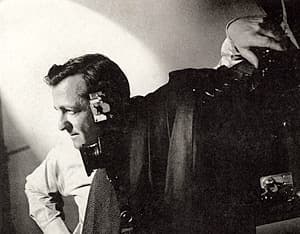About

Martin Bruehl Portrait of Anton Bruehl Cinema Arts c 1937 Howard Greenberg Gallery
Travelling exhibition dates
Araluen Arts Centre, Alice Springs NT, 30 April – 13 June 2011
Monash Gallery of Art, Wheelers Hill VIC, 25 June – 11 September 2011
Queensland University of Technology Art Museum, Brisbane QLD, 21 February – 22 April 2012
See all travelling exhibitions
Education resources
Childrens trail (pdf, 10mb)
Secondary education kit (pdf, 4mb)
Secondary education kit folder (pdf, 480kb)
In the spotlight:
Anton Bruehl
South Australian-born brothers Anton and Martin Bruehl, aged 19 and 24, arrived in New York from Melbourne in 1919, seeking a new home for themselves, their sister, Charlotte, and parents. Dr Siegwart and Minna Bruehl were German immigrants of long standing whose life in Australia had soured during World War I. Anton had been working as an electrical engineer in Melbourne, and Martin as a structural draftsman. Neither could have imagined that their futures from 1927 to 1966 would be side by side as photographers in the Anton Bruehl studio.
The studio was one of the most famous and inventive in New York in the decade when magazines and advertising agencies were switching over to photographic rather than graphic art illustration—long before the ‘Mad Men’ of the 1960s, recently popularised by the hit HBO television series. The Bruehl brothers were a strong team but Anton was the founder and at all times the star and creative force behind the studio.
In 1923, after working for four years at the Western Electric Company in New York, Anton sought a new career based on his hobby of photography. He enrolled at the Clarence H White School of Photography, where students were taught how to apply artistic photography and design to commercial work and professional portraiture. He was an instructor at the school by 1924 and a successful exhibitor in art photography salons by 1926. Following Clarence H White’s premature death in Mexico in early 1925, Anton opened his own studio on 47th Street in 1926. He was in partnership with Ralph Steiner, another White School graduate, and they made their name with an ingenious series of menswear advertisements for Weber and Heilbroner. The series, The Fabric Group, shows the amusing adventures of three cut‑out figures dressed in suits. Steiner, however, dropped out of the studio after only a month, so Anton asked his brother to join him in the business. The Fabric Group advertisements ran weekly in The New Yorker from January 1927 to December 1928 and were replaced by a range of Bruehl’s photographs until December 1929, when Weber and Heilbroner collapsed under the impact of the stock market crash. The Anton Bruehl studio, however, survived and went on to supply advertising images to the new Time Inc business magazine Fortune in 1930, and to the top Condé Nast magazines such as Vanity Fair, Vogue, House and Garden throughout the 1930s–1950s, after he was appointed their chief colour photographer in 1932.
As well as product and fashion advertising of all kinds, Bruehl photographed many of the leading stars of stage and screen. He is most famous, however, for pioneering colour photography for magazines; typically, these were elaborate tableaux created inside the studio, not on location. This reputation began in 1932 under a contractual partnership between Bruehl, New York commercial photographer Fernand Bourges and engravers from Condé Nast to perfect a process of high‑quality colour reproductions. The first of a hundred Bruehl–Bourges images appeared in Vogue in May 1932 and in various publications well into the 1940s, before being superseded by the high‑quality, easier‑to‑use Kodachrome direct colour film released in 1935.
![image: Anton Bruehl not titled [Knitted-to-order sport clothes] 1932
National Gallery of Australia, Canberra](http://cs.nga.gov.au/images/med/152480.jpg) Anton Bruehl not titled [Knitted-to-order sport clothes] 1932
Anton Bruehl not titled [Knitted-to-order sport clothes] 1932National Gallery of Australia, Canberra
Gift of American Friends of the National Gallery of Australia, Inc., New York, NY, USA, made possible with the generous support of Anton Bruehl Jr, 2006
more detail
Bruehl received numerous awards throughout his career. Early on, his 1933 book of black‑and‑white documentary photographs, Mexico, won an award; although, he rarely exhibited or published such personal work—until his 1970 book Tropic patterns on Florida flora. Breuhl did well financially and retired into Florida in the late 1960s. He contributed to a number of New York dealer gallery exhibitions of his work over the decade before his death in San Francisco in 1982, two years after the death of his brother Martin in New York.
Anton’s son, Anton Bruehl Jr visited the National Gallery of Australia in 2001 and felt, somewhat intuitively, that his father wanted him to bring his work home, to Australia. In 2006, through the American Friends of the National Gallery of Australia, Anton Bruehl Jr presented over 100 black‑and‑white and colour photographs, magazine illustration sheets and ephemera covering his father’s career from the 1920s to the 1960s. A number of purchases of Bruehl’s photographs were also made in 2002 with funds provided by The Farrell Family Foundation. Anton Bruehl’s first gallery retrospective, In the spotlight: Anton Bruehl photographs 1920s–1950s comprises a selection of these works and begins its Australian tour at the National Gallery of Australia in Canberra on 23 October.
Gael Newton, Senior Curator, Photography, and curator of In the spotlight
Exhibition book
EXHIBITION BOOK available from the Gallery Shop only $29.95. Read more

